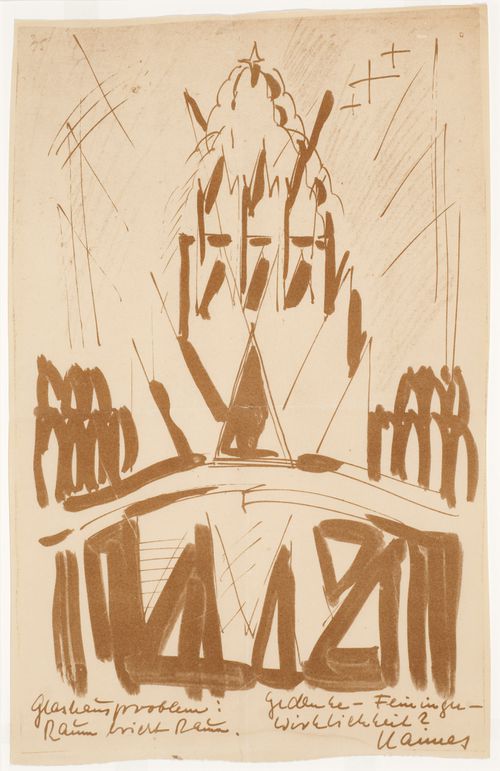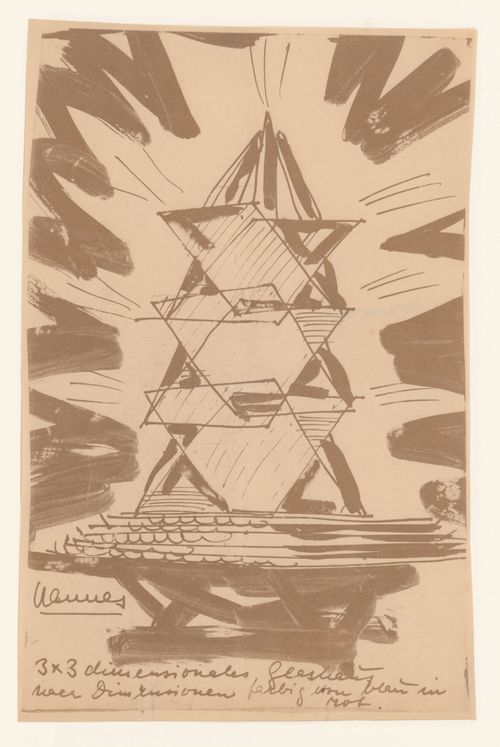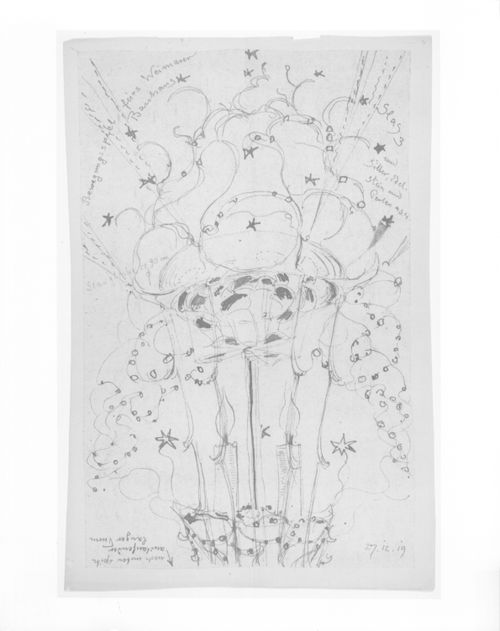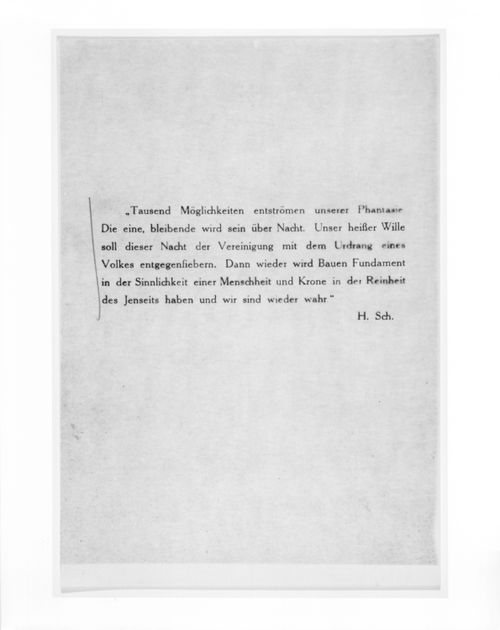Series
Hans Scharoun
AP162.S7
Description:
Series documents the contribution of architect Hans Scharoun to the correspondence circle of Die gläserne Kette, with Scharoun writing under the pseudonym Hannes. Born in 1893 in Bremen, Germany, Scharoun studied archictecture at the Technische Hochschule at Berlin-Charlottenburg between 1912 and 1914. From 1915 to 1918 he worked on a military commission for the rebuilding of East Prussia. In 1919, he joined the Arbeitsrat für Kunst led by Bruno Taut. From 1919 to 1925 he worked independently, taking on private and public commissions as well as architectural projects for exhibitions. He taught at the Akademie für Kunst und Gewerbe in Breslau from 1925 to 1932, and at the Technische Universität Berlin as a town planning professor from 1946 to 1958. In 1956, he won the first prize of the competition for the Philharmonie concert hall in West Berlin. He died in Berlin in 1972. (Source: Ian Boyd Whyte, Bruno Taut and the Architecture of Activism. Cambridge: Cambridge University Press, 1982) The series comprises part of the correspondence of Hans Scharoun to the Die gläserne Kette circle and related drawings.
between 1919 and 1920
Hans Scharoun
Actions:
AP162.S7
Description:
Series documents the contribution of architect Hans Scharoun to the correspondence circle of Die gläserne Kette, with Scharoun writing under the pseudonym Hannes. Born in 1893 in Bremen, Germany, Scharoun studied archictecture at the Technische Hochschule at Berlin-Charlottenburg between 1912 and 1914. From 1915 to 1918 he worked on a military commission for the rebuilding of East Prussia. In 1919, he joined the Arbeitsrat für Kunst led by Bruno Taut. From 1919 to 1925 he worked independently, taking on private and public commissions as well as architectural projects for exhibitions. He taught at the Akademie für Kunst und Gewerbe in Breslau from 1925 to 1932, and at the Technische Universität Berlin as a town planning professor from 1946 to 1958. In 1956, he won the first prize of the competition for the Philharmonie concert hall in West Berlin. He died in Berlin in 1972. (Source: Ian Boyd Whyte, Bruno Taut and the Architecture of Activism. Cambridge: Cambridge University Press, 1982) The series comprises part of the correspondence of Hans Scharoun to the Die gläserne Kette circle and related drawings.
series
between 1919 and 1920
Series
Paul Goesch
AP162.S2
Description:
Series documents the contribution of architect Paul Goesch to the correspondence circle of Die gläserne Kette. Goesch participated using the pseudonym Tancred. Born in Schwerin, Germany in 1985, Goesch studied architecture at the Technische Hochschule at Berlin-Charlottenburg. After his studies, he worked as a civil servant in Kulm and started producing his first drawings and watercolours between 1914 and 1916. He joined the Novembergruppe, an exhibiting group of painters, sculptors, architects and musicians that later merged with the Arbeitsrat für Kunst group led by Bruno Taut. He collaborated with Bruno Taut on the coloured-architecture program in Magdeburg, Germany in 1921, but was later hospitalized for mental illness, first in Göttingen, then in the Teupitz Hospital near Berlin in 1933 or 1934. In 1940, he was taken by the SS to Hartheim Euthanasia Centre where he was murdered on 6 September the same year. (Source: Ian Boyd Whyte, Bruno Taut and the Architecture of Activism. Cambridge: Cambridge University Press, 1982) The series comprises a letter of Paul Goesch to the Die gläserne Kette circle, as well as portraits, including a carte-de-visite, and a diploma.
1890-1911
Paul Goesch
Actions:
AP162.S2
Description:
Series documents the contribution of architect Paul Goesch to the correspondence circle of Die gläserne Kette. Goesch participated using the pseudonym Tancred. Born in Schwerin, Germany in 1985, Goesch studied architecture at the Technische Hochschule at Berlin-Charlottenburg. After his studies, he worked as a civil servant in Kulm and started producing his first drawings and watercolours between 1914 and 1916. He joined the Novembergruppe, an exhibiting group of painters, sculptors, architects and musicians that later merged with the Arbeitsrat für Kunst group led by Bruno Taut. He collaborated with Bruno Taut on the coloured-architecture program in Magdeburg, Germany in 1921, but was later hospitalized for mental illness, first in Göttingen, then in the Teupitz Hospital near Berlin in 1933 or 1934. In 1940, he was taken by the SS to Hartheim Euthanasia Centre where he was murdered on 6 September the same year. (Source: Ian Boyd Whyte, Bruno Taut and the Architecture of Activism. Cambridge: Cambridge University Press, 1982) The series comprises a letter of Paul Goesch to the Die gläserne Kette circle, as well as portraits, including a carte-de-visite, and a diploma.
series
1890-1911
textual records
DR1988:0023:008
Description:
Letter signed "Glas", pseudonym of Taut for Die gläserne Kette correspondence, written on letterhead of the architectural firm Bruno Taut, Max Taut and Franz Hoffmann, Architekten.
December 4, 1920
Letter from Bruno Taut to Wenkel Hablik
Actions:
DR1988:0023:008
Description:
Letter signed "Glas", pseudonym of Taut for Die gläserne Kette correspondence, written on letterhead of the architectural firm Bruno Taut, Max Taut and Franz Hoffmann, Architekten.
textual records
December 4, 1920
Glashausproblem
DR1988:0020:002
Description:
Reproduction of a drawing of Scharoun published in "Ruf zum Bauen", a publication by the Arbeiterrats für Kunst, in 1920. Drawing signed "Hannes", pseudonym of Scharoun for Die gläserne Kette correspondence.
1919 or 1920
Glashausproblem
Actions:
DR1988:0020:002
Description:
Reproduction of a drawing of Scharoun published in "Ruf zum Bauen", a publication by the Arbeiterrats für Kunst, in 1920. Drawing signed "Hannes", pseudonym of Scharoun for Die gläserne Kette correspondence.
DR1988:0020:003
Description:
Reproduction of a drawing of Scharoun published in "Ruf zum Bauen", a publication by the Arbeiterrats für Kunst, in 1920. Drawing signed "Hannes", pseudonym of Scharoun for Die gläserne Kette correspondence.
1919 or 1920
Drawing of a glass house project by Hans Scharoun
Actions:
DR1988:0020:003
Description:
Reproduction of a drawing of Scharoun published in "Ruf zum Bauen", a publication by the Arbeiterrats für Kunst, in 1920. Drawing signed "Hannes", pseudonym of Scharoun for Die gläserne Kette correspondence.
Series
Max Taut
AP162.S9
Description:
Series documents the contribution of architect Max Taut to the correspondence circle of Die gläserne Kette, with Max Taut writing under the pseudonym Kein Name. Born in 1884 in Königsberg, Germany, Max Taut trained in carpentry and building before working in an architectural firm in Karlsruhe, Germany. In 1911, he worked independently, and later shared a practice with his brother Bruno Taut and Franz Hoffman (who joined them after 1914). His first architectural projects consisted primarily of schools. After his military service from 1914 to 1918, Max Taut joined the Arbeisrat für Kunst and the Novembersgruppe. After the First World War, he undertook several architectural projects, both private and public commissions such as housing and office buildings (mainly in Berlin), and also worked on projects for exhibitions. Unable to pratice during the Nazi Regime and the Second World War, Max Taut return to his architectural practice after the war and taught as a professor of architecture at the Hochschule für bildende Kunst in Berlin from 1945 to 1954. He undertook mainly housing development projects during this period. He died in Berlin in 1967. (Source: Ian Boyd Whyte, Bruno Taut and the Architecture of Activism. Cambridge: Cambridge University Press, 1982) The series comprises part of the correspondence of Max Taut to the Die gläserne Kette circle and related drawings. The series also includes photographic materials of some of his architectural projects.
circa 1919 -1920
Max Taut
Actions:
AP162.S9
Description:
Series documents the contribution of architect Max Taut to the correspondence circle of Die gläserne Kette, with Max Taut writing under the pseudonym Kein Name. Born in 1884 in Königsberg, Germany, Max Taut trained in carpentry and building before working in an architectural firm in Karlsruhe, Germany. In 1911, he worked independently, and later shared a practice with his brother Bruno Taut and Franz Hoffman (who joined them after 1914). His first architectural projects consisted primarily of schools. After his military service from 1914 to 1918, Max Taut joined the Arbeisrat für Kunst and the Novembersgruppe. After the First World War, he undertook several architectural projects, both private and public commissions such as housing and office buildings (mainly in Berlin), and also worked on projects for exhibitions. Unable to pratice during the Nazi Regime and the Second World War, Max Taut return to his architectural practice after the war and taught as a professor of architecture at the Hochschule für bildende Kunst in Berlin from 1945 to 1954. He undertook mainly housing development projects during this period. He died in Berlin in 1967. (Source: Ian Boyd Whyte, Bruno Taut and the Architecture of Activism. Cambridge: Cambridge University Press, 1982) The series comprises part of the correspondence of Max Taut to the Die gläserne Kette circle and related drawings. The series also includes photographic materials of some of his architectural projects.
series
circa 1919 -1920
Series
Hans and Wassili Luckhardt
AP162.S6
Description:
Series documents the contribution of architects Hans Luckhardt and Wasilli Luckhardt to the correspondence circle of Die gläserne Kette, with each writing under the pseudonyms Angkor and Zachen respectively. Born in Berlin in 1880, Hans Luckhardt studied architecture at the Technische Hochschule at Karlsruhe, Germany. In 1919, he joined the Novembergruppe, an exhibiting group of painters, sculptors, architects and musicians, and the Arbeitsrat für Kunst, lead by Bruno Taut. These two groups merged in November 1919. The same year, Luckhardt exhibitied his work at the Ausstellung für unbekannte Architekten and contributed to the organization of the Neues Bauen exhibition the next year. In 1921, Hans Luckhardt began his working collaboration with his brother Wassili. Born in Berlin in 1989, Wassili Luckhardt studied archictecture at the Technische Hochschule at Berlin-Charlottenburg and at the Technische Hochschule in Dresden. He undertook his military service from 1914 to 1918. Like his brother Hans, Wasilli joined the Novembergruppeand the Arbeitsrat für Kunst in 1919 and exhibited his work at the Ausstellung für unbekannte Architekten. During their collaboration, the Luckhardt brothers worked on designs for private commisions and competition schemes including some for Berlin and Hanover (1951-1952). Hans Luckhardt died in 1954 in Bad Wiessee. Wassili Luckhardt continued his work as an architect on various architectural projects. He died in 1972 in Berlin. (Source: Ian Boyd Whyte, Bruno Taut and the Architecture of Activism. Cambridge: Cambridge University Press, 1982) The series comprises part of the correspondence of Hans and Wasilli Luckhardt to the Die gläserne Kette circle, along with related drawings and photographs. The series also includes a photograph of a architectural model for a project by the Luckhart brothers.
1919-1920
Hans and Wassili Luckhardt
Actions:
AP162.S6
Description:
Series documents the contribution of architects Hans Luckhardt and Wasilli Luckhardt to the correspondence circle of Die gläserne Kette, with each writing under the pseudonyms Angkor and Zachen respectively. Born in Berlin in 1880, Hans Luckhardt studied architecture at the Technische Hochschule at Karlsruhe, Germany. In 1919, he joined the Novembergruppe, an exhibiting group of painters, sculptors, architects and musicians, and the Arbeitsrat für Kunst, lead by Bruno Taut. These two groups merged in November 1919. The same year, Luckhardt exhibitied his work at the Ausstellung für unbekannte Architekten and contributed to the organization of the Neues Bauen exhibition the next year. In 1921, Hans Luckhardt began his working collaboration with his brother Wassili. Born in Berlin in 1989, Wassili Luckhardt studied archictecture at the Technische Hochschule at Berlin-Charlottenburg and at the Technische Hochschule in Dresden. He undertook his military service from 1914 to 1918. Like his brother Hans, Wasilli joined the Novembergruppeand the Arbeitsrat für Kunst in 1919 and exhibited his work at the Ausstellung für unbekannte Architekten. During their collaboration, the Luckhardt brothers worked on designs for private commisions and competition schemes including some for Berlin and Hanover (1951-1952). Hans Luckhardt died in 1954 in Bad Wiessee. Wassili Luckhardt continued his work as an architect on various architectural projects. He died in 1972 in Berlin. (Source: Ian Boyd Whyte, Bruno Taut and the Architecture of Activism. Cambridge: Cambridge University Press, 1982) The series comprises part of the correspondence of Hans and Wasilli Luckhardt to the Die gläserne Kette circle, along with related drawings and photographs. The series also includes a photograph of a architectural model for a project by the Luckhart brothers.
series
1919-1920
Series
Wenzel Hablik
AP162.S3
Description:
Series documents the contribution of architect Wenzel Hablik to the correspondence circle of Die gläserne Kette. Hablik participated using the pseudonym W.H.. Born in Brüx, Germany, (now Most, in Czech Republic) in 1881, Hablik worked as a porcelina painter from 1895 to 1897 and later as architectural draftsman. Between 1897 to 1902 he studied architecture at the Faschsdule für Tonindustrie und verwandte Gewerbe in Teplitz-Schönau, and at the Kungstgewerbeschule in Vienna in 1902. Between 1905 and 1906, he studied painting at the Akademie für bildenbe Künste in Prague. He worked in Itzehoe, Germany, after an invitation by a patron, Richard Biel, in 1907, where he start collaborating on textile designs with Elisabeth Lindemann, who he married in 1917. His work was exhibited at the Austellung für unbekannte Architeckten in 1919. The same year he joined the Arbeitsrat für Kunst lead by Bruno Taut. In 1925, Hablik published "Zyklus Architektur" an artist folio presenting some of his etched architectural fantasies. He worked for the family workshop by designing textiles and wall hangings. He died in 1934 in Itzehoe. (Source: Ian Boyd Whyte, Bruno Taut and the Architecture of Activism. Cambridge: Cambridge University Press, 1982) The series comprises letters and a drawing by Wenzel Hablik.
circa 1919-1920
Wenzel Hablik
Actions:
AP162.S3
Description:
Series documents the contribution of architect Wenzel Hablik to the correspondence circle of Die gläserne Kette. Hablik participated using the pseudonym W.H.. Born in Brüx, Germany, (now Most, in Czech Republic) in 1881, Hablik worked as a porcelina painter from 1895 to 1897 and later as architectural draftsman. Between 1897 to 1902 he studied architecture at the Faschsdule für Tonindustrie und verwandte Gewerbe in Teplitz-Schönau, and at the Kungstgewerbeschule in Vienna in 1902. Between 1905 and 1906, he studied painting at the Akademie für bildenbe Künste in Prague. He worked in Itzehoe, Germany, after an invitation by a patron, Richard Biel, in 1907, where he start collaborating on textile designs with Elisabeth Lindemann, who he married in 1917. His work was exhibited at the Austellung für unbekannte Architeckten in 1919. The same year he joined the Arbeitsrat für Kunst lead by Bruno Taut. In 1925, Hablik published "Zyklus Architektur" an artist folio presenting some of his etched architectural fantasies. He worked for the family workshop by designing textiles and wall hangings. He died in 1934 in Itzehoe. (Source: Ian Boyd Whyte, Bruno Taut and the Architecture of Activism. Cambridge: Cambridge University Press, 1982) The series comprises letters and a drawing by Wenzel Hablik.
series
circa 1919-1920
DR1988:0023:005
December 27, 1919
DR1988:0020:001
n.d.



